
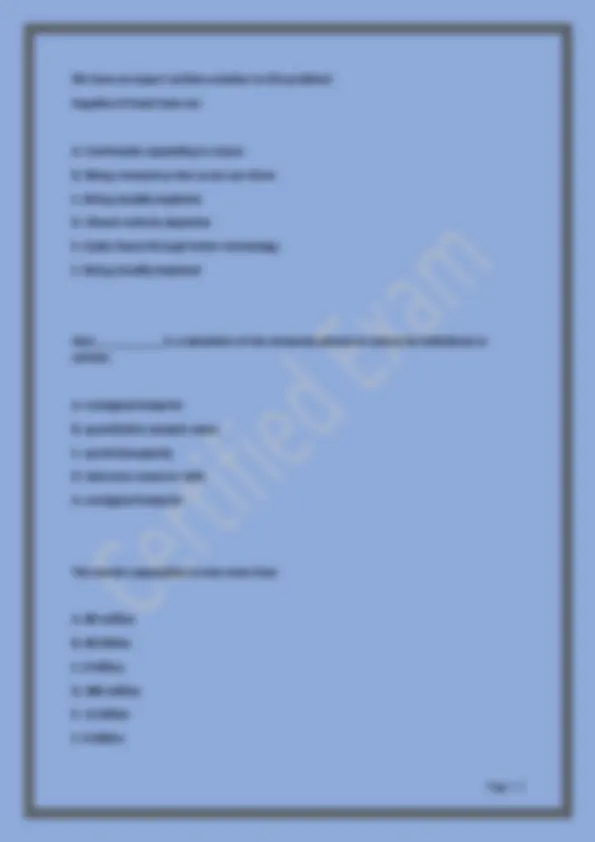
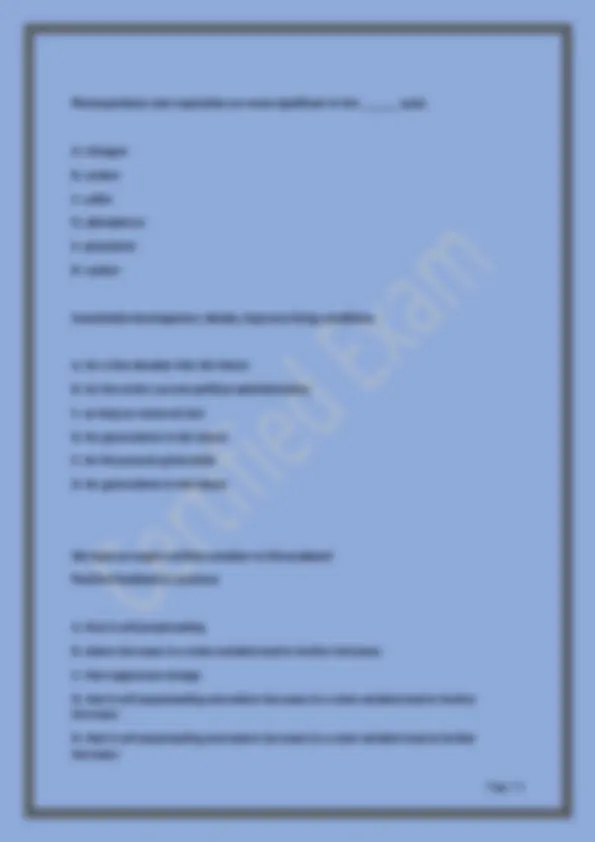
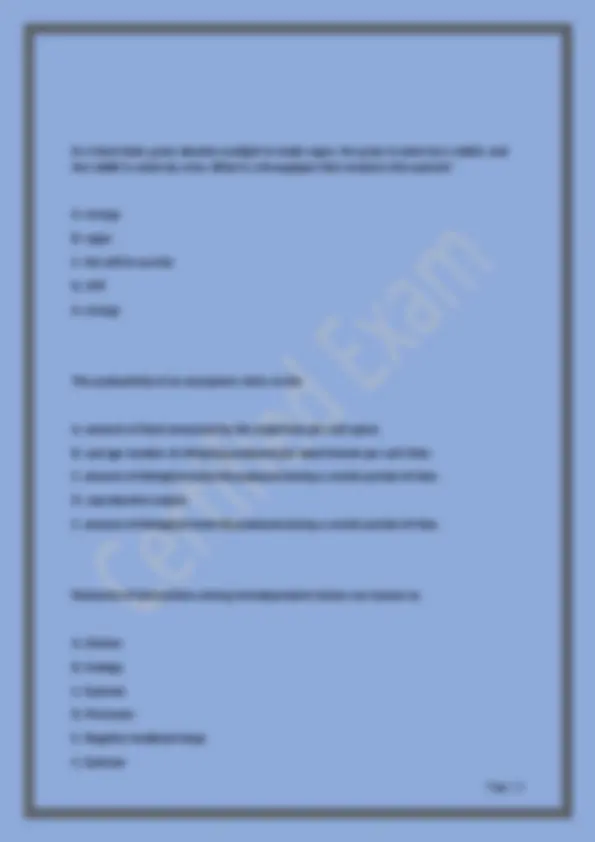
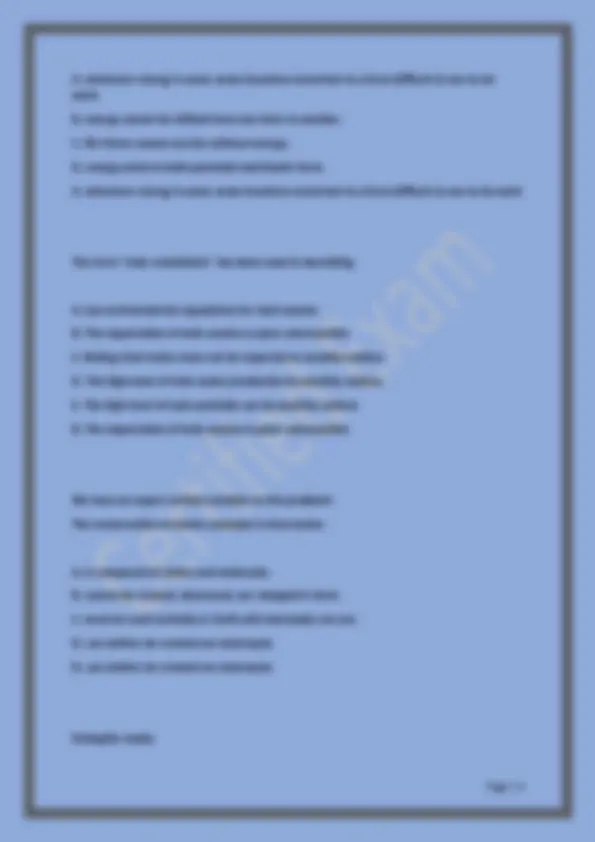
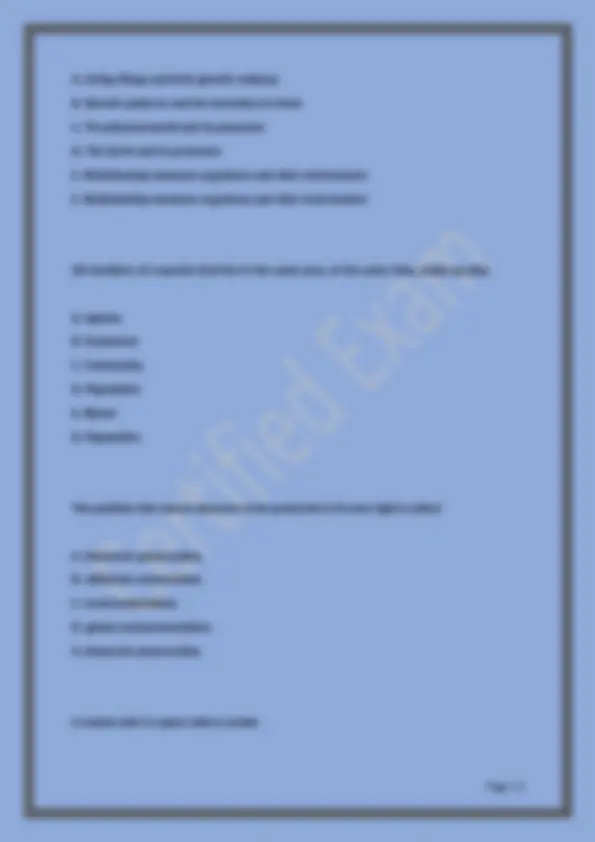
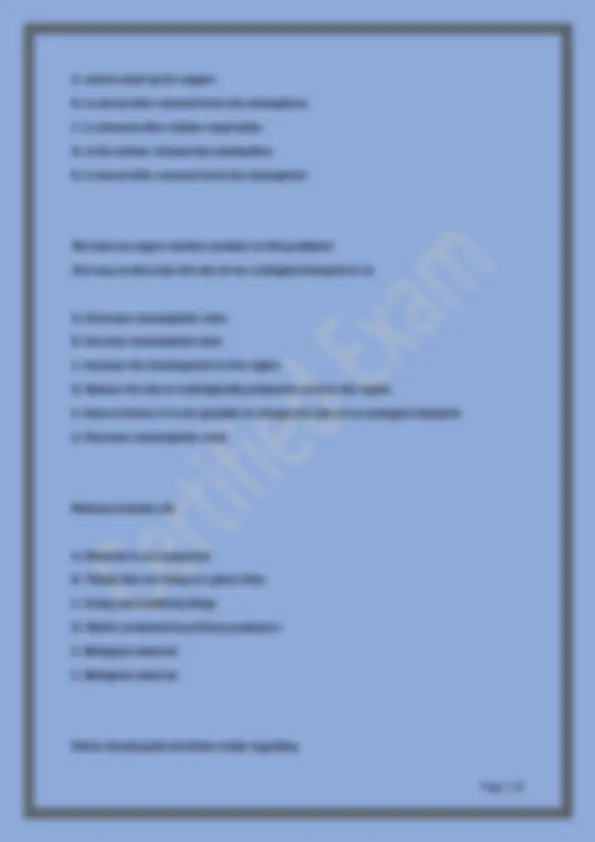
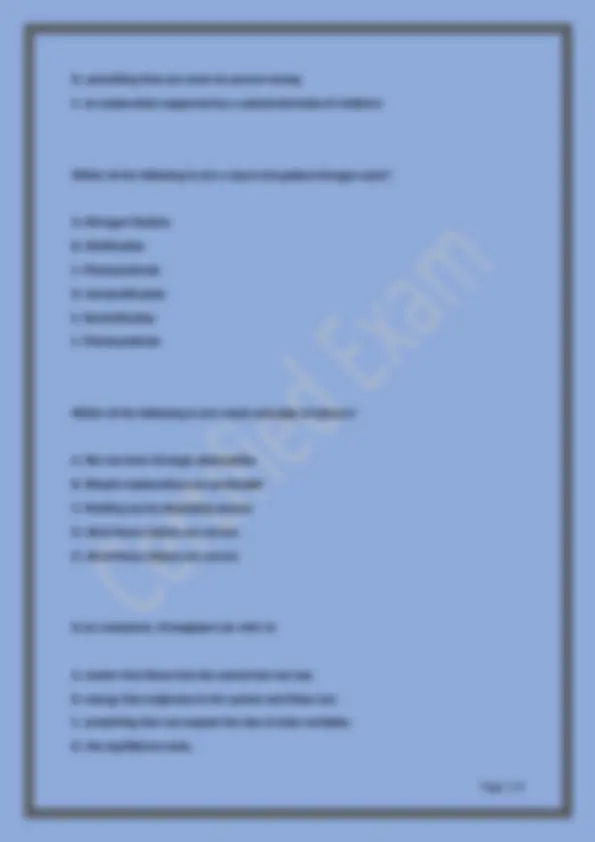
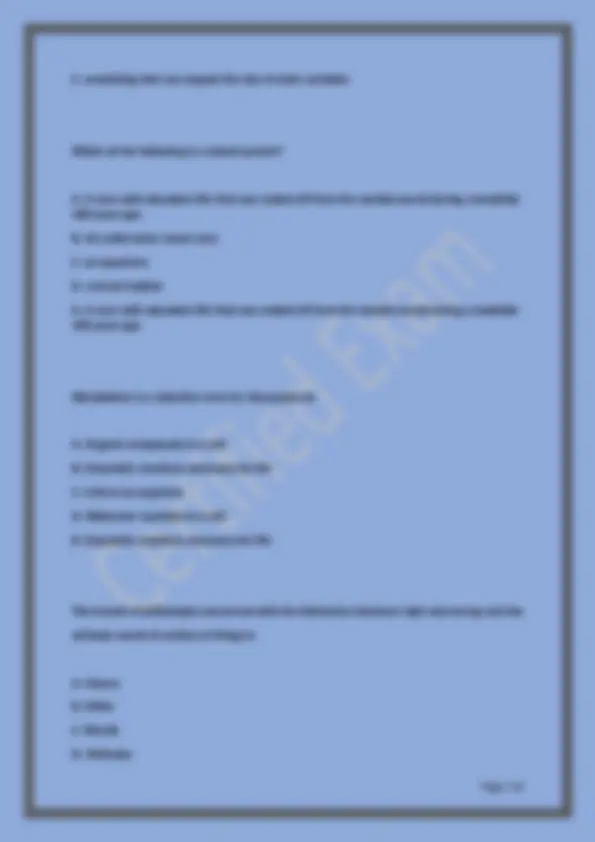
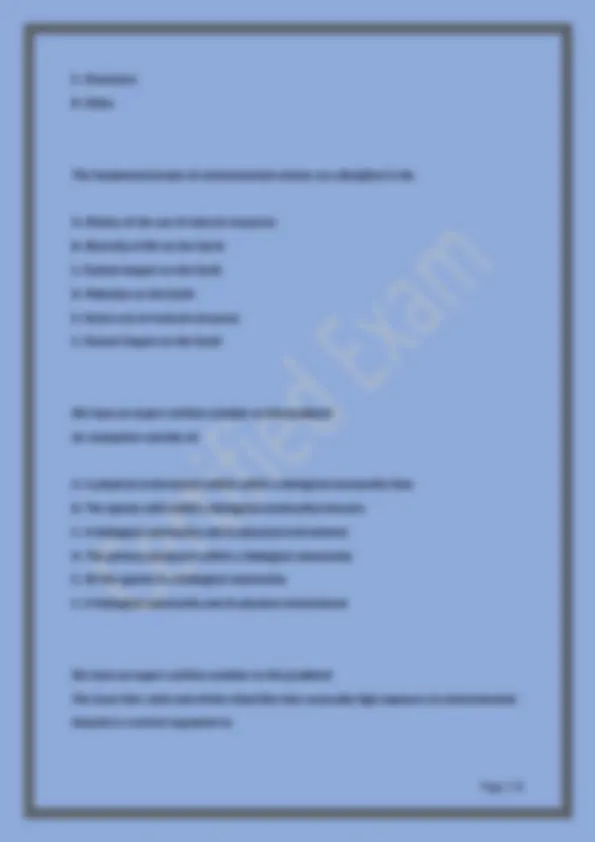
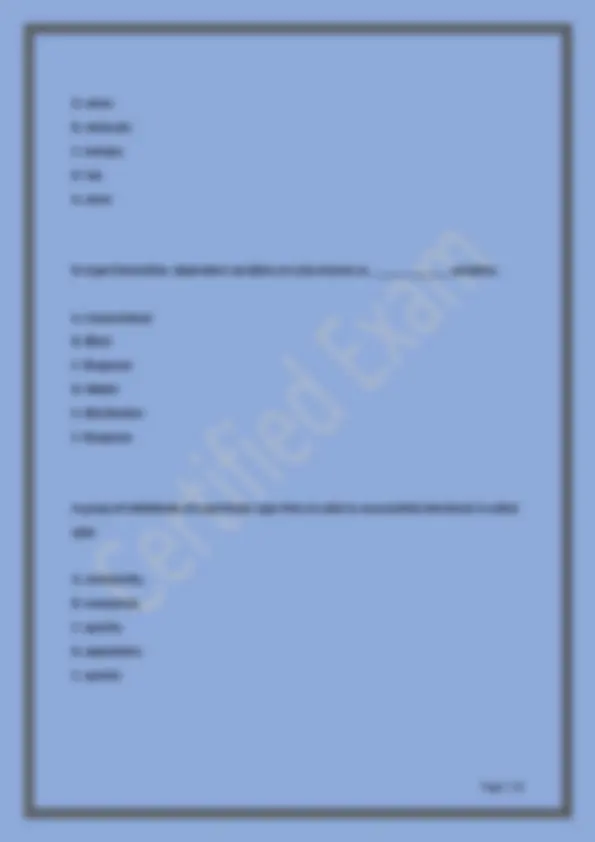


Study with the several resources on Docsity

Earn points by helping other students or get them with a premium plan


Prepare for your exams
Study with the several resources on Docsity

Earn points to download
Earn points by helping other students or get them with a premium plan
Community
Ask the community for help and clear up your study doubts
Discover the best universities in your country according to Docsity users
Free resources
Download our free guides on studying techniques, anxiety management strategies, and thesis advice from Docsity tutors
Environmental Science Final Exam 1: Complete Questions & Answers Answers.
Typology: Exams
1 / 18

This page cannot be seen from the preview
Don't miss anything!











We have an expert-written solution to this problem! One major difference affecting the scope of environmental issues of the past and present is the A. Current ability to alter the natural world through technology B. Relatively new emergence of environmentalists C. Historical ignorance of the interconnected nature of environmental issues D. Development of new fields such as environmental science E. Extremely fast transmission of information through the Internet A. Current ability to alter the natural world through technology Another word for "steward" is A. Organizer B. Caretaker C. Participant D. Consumer E. Leader B. Caretaker As energy is used and transformed, it gradually becomes _______ quality and _______ concentrated. A. Higher; more
B. Lower; more C. Higher; less D. Lower; less E. As energy is used, it does not become transformed; there is no change in quality, and it stays the same concentration D. Lower; less We have an expert-written solution to this problem! Environmental science is a __________. A. Narrowly defined set of physical, life, and social sciences B. Theoretical approach in interpreting the environment C. Way to see the world in scientific terms D. Systematic approach in learning about the environment E. Special set of problem-solving skills D. Systematic approach in learning about the environment We have an expert-written solution to this problem! The ability of an ecosystem to recover from a disturbance is known as A. resilience B. stability C. fitness D. emergence A. resilience
Photosynthesis and respiration are most significant in the ______ cycle. A. nitrogen B. carbon C. sulfur D. phosphorus E. potassium B. carbon Sustainable development, ideally, improves living conditions A. for a few decades into the future B. for the entire current political administration C. as long as resources last D. for generations in the future E. for the present generation D. for generations in the future We have an expert-written solution to this problem! Positive feedback is a process A. that is self perpetuating B. where increases in a state variable lead to further increases C. that suppresses change D. that is self perpetuating and where increases in a state variable lead to further increases D. that is self perpetuating and where increases in a state variable lead to further increases
In a food chain, grass absorbs sunlight to make sugar, the grass is eaten by a rabbit, and the rabbit is eaten by a fox. What is a throughput that connects this system? A. energy B. sugar C. the will to survive D. ATP A. energy The productivity of an ecosystem refers to the A. amount of food consumed by the organisms per unit space. B. average number of offspring produced per adult female per unit time. C. amount of biological material produced during a certain period of time. D. reproductive output C. amount of biological material produced during a certain period of time. Networks of interactions among interdependent factors are known as A. Science B. Ecology C. Systems D. Processes E. Negative feedback loops C. Systems
D. Carbohydrate; protein E. Lipid; protein E. Lipid; protein If everybody in the world used resources at the rate that people in the United States do, A. People would be healthier and happier worldwide B. Our current resources would run out quickly C. Violent conflicts would decrease because basic needs would be met D. Economies would prosper E. More people would experience health problems because people in more prosperous countries experience more stress B. Our current resources would run out quickly Biocentric preservationists, first led by John Muir, advocate saving natural areas for their A. Aesthetic and spiritual values and wildlife habitat B. Hunting and fishing value C. Wood and mineral resources for the future D. Tourism and recreation potential E. Economic value in cleaning the air and preventing soil erosion A. Aesthetic and spiritual values and wildlife habitat We have an expert-written solution to this problem! The second law of thermodynamics states that
A. whenever energy is used, some becomes converted to a form difficult to use to do work. B. energy cannot be shifted from one form to another. C. life forms cannot survive without energy. D. energy exists in both potential and kinetic form. A. whenever energy is used, some becomes converted to a form difficult to use to do work The term "toxic colonialism" has been used in describing A. Lax environmental regulations for toxic wastes B. The exportation of toxic wastes to poor communities C. Rulings that toxins must not be exported to wealthy nations D. The high level of toxic waste production by wealthy nations E. The high level of toxic pesticide use by wealthy nations B. The exportation of toxic wastes to poor communities We have an expert-written solution to this problem! The conservation of matter principle is that matter A. is composed of atoms and molecules. B. cannot be created, destroyed, nor changed in form. C. must be used carefully or Earth will eventually run out. D. can neither be created nor destroyed. D. can neither be created nor destroyed. Ecologists study:
A. atoms wash up for supper. B. is stored after removal from the atmosphere. C. is released after cellular respiration. D. is the carbon released by combustion. B. is stored after removal from the atmosphere We have an expert-written solution to this problem! One way to decrease the size of our ecological footprint is to A. Decrease consumption rates B. Increase consumption rates C. Increase the development in the region D. Reduce the size of a biologically productive area in the region E. None of these; it is not possible to change the size of an ecological footprint A. Decrease consumption rates Biomass includes all: A. Material in an ecosystem B. Things that are living at a given time C. Living and nonliving things D. Matter produced by primary producers E. Biological material E. Biological material Ethics should guide decisions made regarding
A. Environmental issues B. Economic issues C. Development issues D. Social justice issues E. All of the above issues E. All of the above issues Experiments in which conditions are deliberately altered and all other variables are held constant are known as ___________ experiments. A. Manipulative B. Natural C. Hypothetical D. Probability E. Double-blind A. Manipulative Primary consumers are also known as: A. Carnivores B. Scavengers C. Decomposers D. Herbivores E. Top carnivores D. Herbivores
D. something that can never be proven wrong C. an explanation supported by a substantial body of evidence Which of the following is not a step in the global nitrogen cycle? A. Nitrogen fixation B. Nitrification C. Photosynthesis D. Ammonification E. Denitrification C. Photosynthesis Which of the following is not a basic principle of science? A. We can learn through observation B. Simpler explanations are preferable C. Nothing can be absolutely proven D. All of these choices are correct D. All of these choices are correct In an ecosystem, throughput can refer to A. matter that flows into the system but not out. B. energy that originates in the system and flows out. C. something that can expand the size of state variables. D. the equilibrium state.
C. something that can expand the size of state variables Which of the following is a closed system? A. A cave with abundant life that was sealed off from the outside world during a landslide 100 years ago. B. An underwater ocean cave C. an aquarium D. a forest habitat A. A cave with abundant life that was sealed off from the outside world during a landslide 100 years ago Metabolism is a collective term for thousands of: A. Organic compounds in a cell B. Enzymatic reactions necessary for life C. Cells in an organism D. Molecular reactions in a cell B. Enzymatic reactions necessary for life The branch of philosophy concerned with the distinction between right and wrong and the ultimate worth of actions of things is A. Values B. Ethics C. Morals D. Attitudes
A. Sustainable development B. Environmental justice C. Economic development D. Urban renewal E. Interpretive science B. Environmental justice The damage to an ecosystem caused by a hurricane or flood can be referred to as A. An open system B. An emergent property C. Equilibrium in nature D. A disturbance E. A negative feedback loop D. A disturbance We have an expert-written solution to this problem! From the following statements and questions, which is the best example of deductive reasoning? A. If all insects have six legs, then butterflies have six legs B. In repeated tosses of a coin, there is a 50/50 chance of each toss resulting in a "head" C. How many times will the toss of coins turn "heads-up" if 100 times toss a coin? D. Since every insect I have examined so far has six legs, I conclude that all insects must have six legs E. All of these are examples of deductive reasoning A. If all insects have six legs, then butterflies have six legs
A biological community consists of all: A. Populations living and interacting in an area B. Members of a species living in the same area C. Living things on Earth D. Populations of a given species E. Members of a species living in the same biome A. Populations living and interacting in an area Environmentalism stemming from the publication of Rachel Carson's Silent Spring differed from earlier North American conservation perspectives by A. Focusing on human population growth B. Placing more emphasis on pollution problems C. Emphasizing international problems D. Encouraging energy efficiency E. Emphasizing the value of natural resources B. Placing more emphasis on pollution problems The smallest particle exhibiting the characteristics of an element is a/an